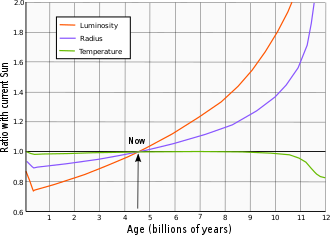
Back Sonligsterkte Afrikaans إضاءة شمسية Arabic Сонечная сьвяцільнасьць BE-X-OLD Слънчева светимост Bulgarian সৌর জ্যোতি Bengali/Bangla Lluminositat solar Catalan Sluneční zářivost Czech Хĕвел çутатаслăхĕ CV Sonnenleuchtkraft German Suna lumeco Esperanto

The solar luminosity (L☉) is a unit of radiant flux (power emitted in the form of photons) conventionally used by astronomers to measure the luminosity of stars, galaxies and other celestial objects in terms of the output of the Sun.
One nominal solar luminosity is defined by the International Astronomical Union to be 3.828×1026 W.[2] The Sun is a weakly variable star, and its actual luminosity therefore fluctuates.[3] The major fluctuation is the eleven-year solar cycle (sunspot cycle) that causes a quasi-periodic variation of about ±0.1%. Other variations over the last 200–300 years are thought to be much smaller than this.[4]
- ^ Ribas, Ignasi (February 2010), "The Sun and stars as the primary energy input in planetary atmospheres" (PDF), Solar and Stellar Variability: Impact on Earth and Planets, Proceedings of the International Astronomical Union, IAU Symposium, vol. 264, pp. 3–18, arXiv:0911.4872, Bibcode:2010IAUS..264....3R, doi:10.1017/S1743921309992298, S2CID 119107400
- ^ "Resolution B3 on recommended nominal conversion constants for selected solar and planetary properties" (PDF). International Astronomical Union. 2015. Retrieved 5 June 2018.
- ^ Vieira, L. E. A.; Norton, A.; Dudok De Wit, T.; Kretzschmar, M.; Schmidt, G. A.; Cheung, M. C. M. (2012). "How the inclination of Earth's orbit affects incoming solar irradiance" (PDF). Geophysical Research Letters. 39 (16): L16104 (8 pp.). Bibcode:2012GeoRL..3916104V. doi:10.1029/2012GL052950. insu-01179873.
- ^ Noerdlinger, Peter D. (2008). "Solar Mass Loss, the Astronomical Unit, and the Scale of the Solar System". Celestial Mechanics and Dynamical Astronomy. 801: 3807. arXiv:0801.3807. Bibcode:2008arXiv0801.3807N.
© MMXXIII Rich X Search. We shall prevail. All rights reserved. Rich X Search